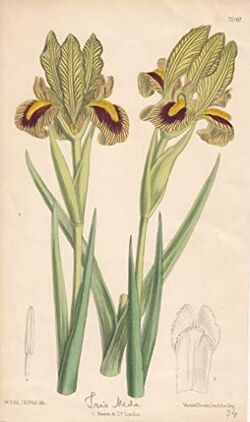Biology:Iris meda
| Iris meda | |
|---|---|

| |
| Iris meda, botanical illustration drawn by Matilda Smith and lithographed by J.N. Fitch | |
| Scientific classification | |
| Kingdom: | Plantae |
| Clade: | Tracheophytes |
| Clade: | Angiosperms |
| Clade: | Monocots |
| Order: | Asparagales |
| Family: | Iridaceae |
| Genus: | Iris |
| Species: | I. meda
|
| Binomial name | |
| Iris meda Stapf.
| |
| Synonyms[1][2] | |
|
Iris fibrosa Freyn | |
Iris meda is a species in the genus Iris, it is also in the subgenus of Iris and in the Oncocyclus section. It is from the desert mountains and hills of Media (which is now Iran) and has long grey-green leaves with cream, pale yellow or yellow flowers, which have purple or dark brown patches and yellow beards.
Description
Iris meda has small, about 1 cm (0 in) long,[3] thin, stoloniferous-like rhizomes, and long secondary roots underneath the rhizome.[4]
It has upright,[3] narrow, blade-shaped foliage,[5] which are grey-green and 10–15 cm (4–6 in) long,[4] and 0.15–0.4 cm (0–0 in) wide.[3]
The plant in total can reach between 10–25 cm (4–10 in) tall,[2][6][7] with straight stems[4] reaching 20 cm (8 in) high.[5][8]
It blooms between April and May,[3] and has small flowers,[3] that have a range of colour variations,[5] that come in shades from cream or whitish ground color,[3][6][2] lemon yellow to creamy straw-yellow ground colours.[5][8] It is similar in form to Iris sari,[4] which does not grow in Iran and does not have folded falls.[5]
Like other irises, it has 2 pairs of petals, 3 large sepals (outer petals), known as the 'falls' and 3 inner, smaller petals (or tepals), known as the 'standards'.[9]:17 The standards are oblanceolate, 6–7 cm (2–3 in) long and 3.5 cm (1 in) wide.[3]
The falls are 6 cm (2 in) long,[3] thin and either undulating,[8][6] or curled over.[3][5] They have a large chestnut-maroon-black,[5] or dark brown[6] or purplish signal patch in the centre of the petal.[3][2][7] Also they have a dense,[5][4] narrow 'beard' of long yellow hairs.[3][6][2] They also have greenish yellow style arms which are veined near apex.[3]
After it has flowered it produces a seed capsule and seeds that have not been described.[3]
Biochemistry
As most irises are diploid, having two sets of chromosomes. This can be used to identify hybrids and classification of groupings.[9]:24 It has a chromosome count of 2n=20.[4][2]
Taxonomy
The Latin specific epithet meda refers to Media (a region of Persia). Similar to Apis mellifera meda (the Persian honey bee or Iranian honey bee).[10]
It was first found in Persia,[6] and then described and published by Austrian born botanist Otto Stapf in Denkschr. Acad. Wein (Denkschriften der Akademie der Wissenschaften = Memoranda of the Academy of Sciences) vol.50 on page 20, (collected on the Bot. Ergeb. Polak. Exped. Pers.) in 1885.[6][1][11]
It is listed in the Encyclopedia of Life as Iris meda,[12] and it is a RHS accepted name of iris.[13] It was verified by United States Department of Agriculture and the Agricultural Research Service on 15 November 2002, then updated on 4 April 2003.[14]
Distribution and habitat
It is native to temperate Asia.[14]
Range
It is found in Iran.[12][7][2] Within the region of Mianeh, East Azerbaijan.[5]
Habitat
It grows on either stony clay,[5] or sandy or gravelly soils,[3] of dry hills,[3] desert mountains,[4] and Kurdish steppes.[5] At altitudes of between 1,400–2,400 m (4,600–7,900 ft) above sea level.[3]
Cultivation
In the UK, it does not survive in cultivation as it needs dry conditions and very dry summers.[3]
Hybrids
Iris meda has the following two crosses; 'Amboy Agate' (Iris samariae X I. meda)[15] and 'Moleskin'.[6]
Culture
In 1991, the government of Iran issued a set of postage stamps with the flora of Iran on them, which included "Iris meda".[16]
Toxicity
Like many other irises, most parts of the plant are poisonous (including rhizome and leaves), and if mistakenly ingested can cause stomach pains and vomiting. Handling the plant may cause skin irritation or an allergic reaction.[17]
References
- ↑ 1.0 1.1 "Iris meda Stapf". http://www.theplantlist.org/tpl1.1/record/kew-322121.
- ↑ 2.0 2.1 2.2 2.3 2.4 2.5 2.6 "Iris summary". pacificbulbsociety.org. 14 April 2014. http://www.pacificbulbsociety.org/pbswiki/files/Iris/Iris_Summary.pdf.
- ↑ 3.00 3.01 3.02 3.03 3.04 3.05 3.06 3.07 3.08 3.09 3.10 3.11 3.12 3.13 3.14 3.15 3.16 British Iris Society (1997) A Guide to Species Irises: Their Identification and Cultivation, p. 81, at Google Books
- ↑ 4.0 4.1 4.2 4.3 4.4 4.5 4.6 "chapitre I (partie 5) Les Oncocyclus II" (in fr). irisbotanique.over-blog.com. http://irisbotanique.over-blog.com/article-chapitre-i-partie-5-les-oncocyclus-ii-124148159.html.
- ↑ 5.00 5.01 5.02 5.03 5.04 5.05 5.06 5.07 5.08 5.09 5.10 "Iris meda". https://www.rareplants.co.uk/product/iris-meda/.
- ↑ 6.0 6.1 6.2 6.3 6.4 6.5 6.6 6.7 Pries, Bob (21 November 2016). "(SPEC) Iris meda Stapf". http://wiki.irises.org/Spec/SpecMeda.
- ↑ 7.0 7.1 7.2 Kramb, D. (3 December 2003). "Iris meda". http://www.signa.org/index.pl?Iris-meda.
- ↑ 8.0 8.1 8.2 Stebbings, Geoff (1997). The Gardener's Guide to Growing Irises. Newton Abbot: David and Charles. p. 69. ISBN 978-0715305393. https://archive.org/details/gardenersguideto00steb.
- ↑ 9.0 9.1 Austin, Claire (2005). Irises; A Garden Encyclopedia. Timber Press. ISBN 978-0881927306.
- ↑ Veisi, H.; Nazemi-Rafie, J.; Azizi, A.; Rajabi-Maham, H. (2020). "Genetic characteristics of the Iranian honey bee, Apis mellifera meda, based on mitochondrial genes of ND4, ND4L and ND6 and their internal transcribed spacers". Insectes Soc. 67 (3): 439–448. doi:10.1007/s00040-020-00769-2.
- ↑ "Iris meda | International Plant Names Index". https://www.ipni.org/n/438863-1.
- ↑ 12.0 12.1 "Iris meda". eol.org. https://eol.org/pages/5866799/data.
- ↑ "Iris meda". https://www.rhs.org.uk/Plants/141756/i-Iris-meda-i/Details%3Freturnurl%3D%252Fplants%252Fsearch-results%253F.
- ↑ 14.0 14.1 "Taxon: Iris meda Stapf". http://tn-grin.nat.tn/gringlobal/taxonomydetail.aspx?id=428640.
- ↑ "ArAmboyAgate < Ar < Iris Wiki". https://wiki.irises.org/Ar/ArAmboyAgate.
- ↑ "Stamp: Iris meda (Iran) (Iranian new year and first day of spring: flowers) Mi:IR 2413" (in en). https://colnect.com/en/stamps/stamp/476628-Iris_meda-Iranian_new_year_and_first_day_of_spring_flowers-Iran.
- ↑ David G Spoerke and Susan C. Smolinske Toxicity of Houseplants, p. 236, at Google Books
Other sources
External links
- https://www.alamy.com/stock-photo-iris-meda-native-of-persia-38474236.html Has image of Iris meda
Wikidata ☰ Q5940486 entry
 |

